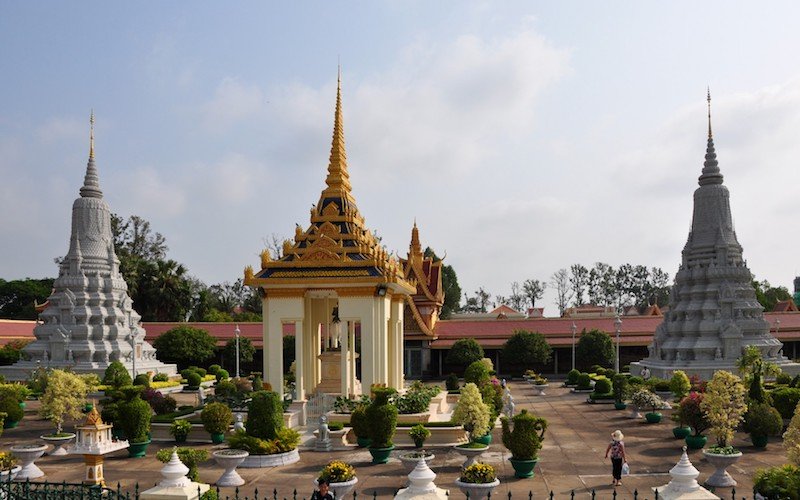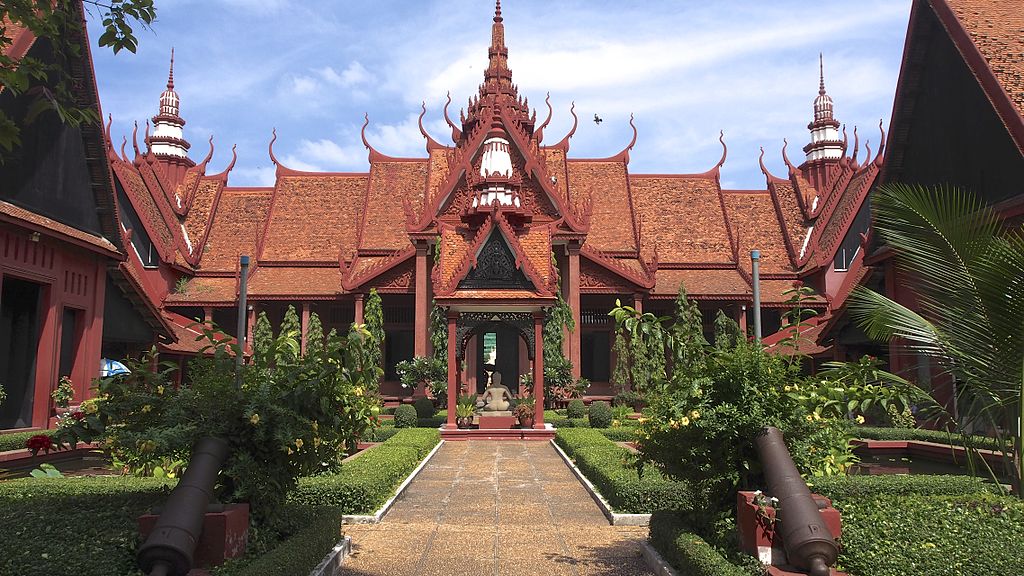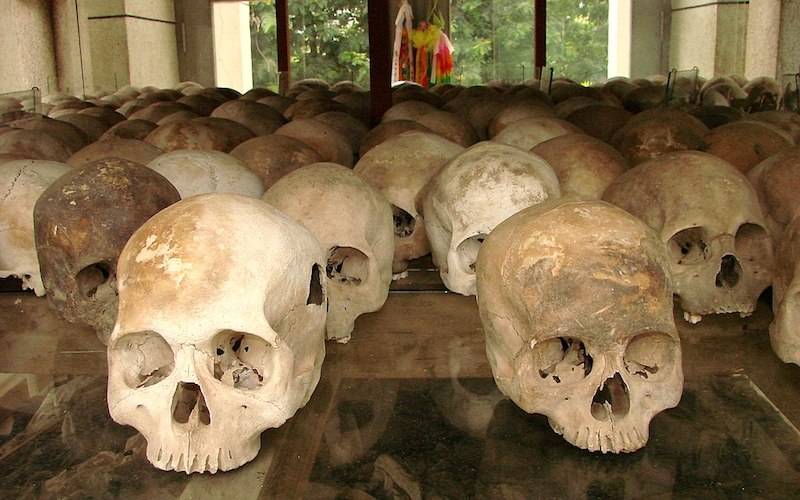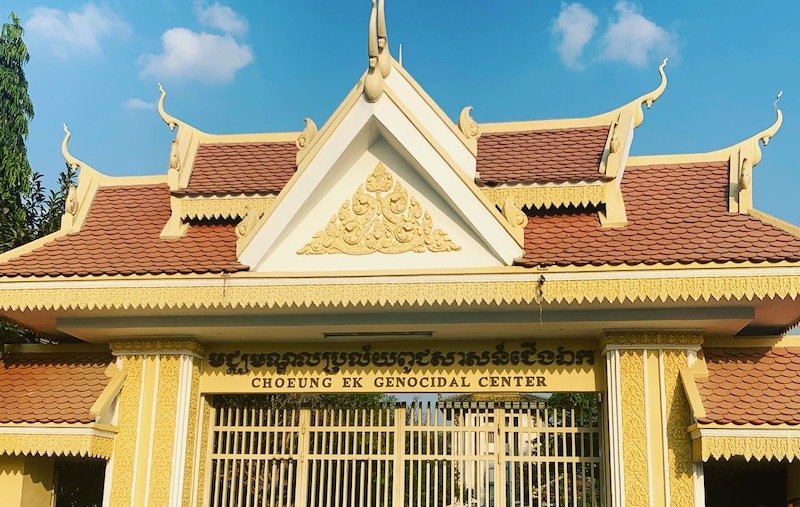This week, I arrived in Phnom Penh – the bustling capital of Cambodia. It’s a city full of history, temples and palaces – a feast for any cultural traveller and I’m today I’m blogging about what to do in Phnom Penh.
I have to admit that I was pleasantly surprised with Phnom Penh. I’d heard bad stories about mental traffic, robberies and rubbish everywhere. Ok, so there are no traffic lights, but the traffic seems to work. Despite a bit of rubbish and construction work going on around the city, that’s no surprise considering that there was a communist regime and genocide going on in the 1970’s and in 1976 the city was a ghost town. The main boulevards and waterfronts have well set out pedestrian walkways and zebra crossings. They are clean and the riverside is laden with flowers in lotus shaped flower pots.
I actually preferred Phnom Penh to Bangkok, the capital of Thailand – where I got severe asthma due to the pollution and people packed on the MRT during rush hour.
Highlights of Cambodia’s capital include the Royal Palace, Silver Pagoda, Wat Phnom and the genocide museum. Here’s what to do in Phnom Penh…
What to do in Phnom Penh
The Royal Palace
Built in the 1860’s, the opulent Phnom Penh Royal palace has since served as the royal residence in Phnom Penh, discounting a brief point of abandonment during the Khmer Rouge. On site, there are multiple quarters and golden temples, each even more striking than the next. The most famous is the Silver Pagoda (see below).
You’ll get a chance to learn about the history of the royal family in Cambodia and the history of Phnom Penh with the help of informational plaques and guides available on site. When you visit, dress appropriately for Buddhist culture. Women should cover their knees and shoulders while men should wear shirts with sleeves.

Silver Pagoda
This gorgeous Buddhist temple within the Royal Palace complex represents the epitome of South East Asian culture. From the monks dressed in bright orange to the shiny silver and gold tips of the stupas, the Silver Pagoda brings everything you anticipated about Cambodia to life.
Once approaching the entrance of the temple, you’ll realize why this temple has its name. The floor is protected in 5,000 glittering silver tiles as a present to Buddha. To protect these tiles, you cannot walk on them, but you can look. Most of them are covered, but the best place to take a glimpse of these is near the entrance.
Head up the grand staircase and you’ll be led to the Temple of the Emerald Buddha (baccarat crystal). There is also a real gold Maitreya Buddha who is sparkling in 2086 diamonds. As if that wasn’t lavish enough, this Buddha sits next to an 80kg bronze Buddha, a silver-gold Buddha and hundreds of valuable Buddha statues, each with its own story to tell.
National Museum of Cambodia
Located right by the Royal Palace, the National Museum has artefacts dating right back to the ancient period called Angkorian. Several rooms show a range of extraordinary lingas, statues and other items, involving the Leper King from Siem Reap and a huge 11thcentury bronze Vishnu (Hindu God of balance). It prepares visitors with abundant knowledge ahead of a trip to Angkor Wat Archaeological Park.

Tuol Sleng Genocide Museum
This former high school in central Phnom Penh makes for a sobering visit, due to the horrific role it played during the Khmer Rouge regime. Back then, the former school was transformed into a political prisoners’ camp known as Security Prison 21 (S-21). Only seven prisoners survived, while many others were tortured and killed there, or sent to their deaths at Choeung Ek. A lot of the site has been left as it was found in 1979 when the Vietnamese army liberated Phnom Penh. Tiny brick cells, blood-splattered walls and abandoned torture tools provide an important insight into the brutal regime. It’s one of the world’s most infamous Dark Tourism Destinations.

Choeung Ek Genocidal Center
The Pol Pot-led Khmer Rouge took over Cambodia between 1975 and 1979 with an estimated two million people killed or dying from exhaustion and starvation. Nearly 9,000 bodies were discovered at the mass graves of Choeung Ek, known as the Killing Fields. Today serving as a memorial, the site has a Buddhist stupa filled with human skulls recovered from the fields. despite being a depressing day and a bit of a shock to the system, Cambodian people recommend that tourists take the Phnom Penh Killing fields tour to learn about the history of the country ad pay their respects. Visitors can learn more through a headset-guided walking tour and walk around the exhumed graves (cost at time of writing – $3).

Cambodian Living Arts’ Theatre Show
As the main organisation tasked with bringing traditional arts back to life and steering them in a new, modern direction, Cambodian Living Arts trains musicians, dancers, singers, and other performers, providing them with the props to make a living from their art. Some of their efforts includes the daily shows at the capital’s National Museum, which run from 7-8pm. The Traditional Dance Show takes spectators on a journey from Angkor’s palaces to the villages currently through music, theatre and song.
Wat Phnom
Currently the capital’s only hill, this well-maintained park, which marks the official centre of the capital and doubles up as a roundabout, provides a welcome interval from Phnom Penh’s soaring heat. Wat Phnom pagoda with the complexly detailed temple sits above and welcomes the visitors, with tourists paying a $1.00 fee. Stay well clear of the mischievous and often spiteful monkeys.
Koh Dach
More commonly known as Silk Island, Koh Dach is around a 1-hour trip from the capital, consisting of a short ferry ride to the island that sits right in the middle of the Mekong River. Houses on Koh Dach are stilted as there are annual floods in September and October.
Guests can learn about the traditional Cambodian silk weaving by paying a visit to the villages across the islands, where they can see workers use handlooms to spin silk and others dye materials to make spectacular designs. The island is also home to an immaculate countryside and a fantastic way to escape the city for the day without going a long way.
Phnom Tamao Wildlife Rescue Center
NGO Wildlife Alliance works tirelessly to rescue, rehabilitate and conserve the country’s swathe of endangered and rare wildlife from the clutches of illegal traffickers and poachers. Animals that are rescued are taken to Phnom Tamao Wildlife Rescue Center to be nursed back to health before being freed back into the wild.
The centre’s day in the life of a zookeeper programme gives guests the chance to get up close and personal to the wildlife, with all funds being pumped back into the project. Guests can enter the tigers’ private den, hand-feed elephants, feed baby macaques and get close to gibbons, otters and leopards.
Phnom Penh Food Tours
The recently launched sister tour of the successful Siem Reap Food Tours gives visitors the chance to feast on food cooked fresh on the streets. The two tour options – morning and evening – both take guests off-the-beaten-track to sample authentic Cambodian flavours at markets, street food stalls and hole-in-the-wall eateries, all led by an informative guide. This is a brilliant opportunity to sample the diversity of Cambodian food in a fun and safe way.
Sunset Boat Trip
One of the best Phnom Penh tours is the sunset boat trip. There is no better way to start the evening than with a relaxing jaunt along the Mekong or Tonle Sap rivers as the sun melts into the horizon to mark the end of another day. There are plenty of options which vary in price and quality. Tara Boats and Kanika come recommended and offer a range of boat trips, including entertainment and buffet dinner.
Further Reading on What to do in Phnom Penh
If you enjoyed this article on What to do in Phnom penh you might also like to read about…
What to Pack for Southeast Asia
To help you pack for your trip to Southeast Asia, the below list of must-have items can be really useful.
First of all, you need a plug converter. Absolutely essential wherever you travel.
To avoid pickpockets, we recommend bringing with you a theft-proof backpack, or a crossbody bag, and a money bag.
It is also a good idea to get a hanging toiletry bag, which is a fantastic way to keep all your belongings organized; and a practical rolling suitcase like the one below by Samsonite in lightweight polycarbonate.

In order to stay healthy while travelling, activated charcoal helps with stomach distress absorbing toxins that may be in your system; and natural jet-lag remedy pills help you sleeping while boosting your immunity and can avoid you to ruin precious days of sightseeing.
For all the ladies, it can be a great idea to get a maxi dress: very versatile as it can be worn at any time of the day and it is ideal to go to temples too.

A scarf that you can put on your shoulders as well as on your head while visiting a sacred place.
Last, sunglasses and sunscreen are also vital to protect you from UV radiation that can be pretty intense in Southeast Asia.

Pingback: Shopping in Phnom Penh - Shopping Guide for Phnom Penh